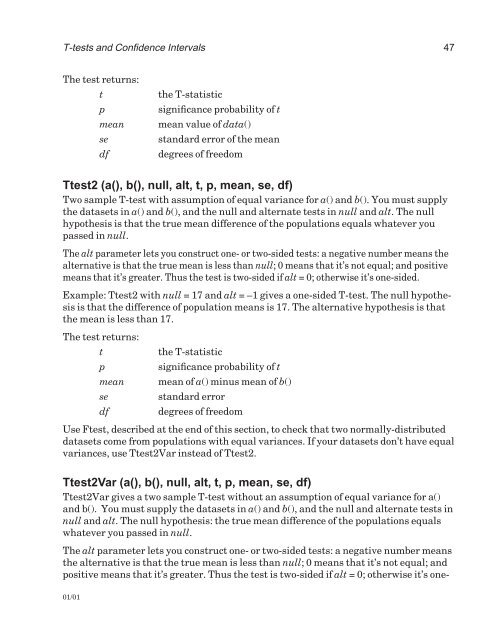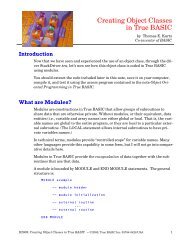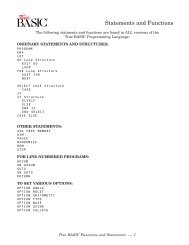Download the documentation - True BASIC
Download the documentation - True BASIC
Download the documentation - True BASIC
You also want an ePaper? Increase the reach of your titles
YUMPU automatically turns print PDFs into web optimized ePapers that Google loves.
T-tests and Confidence Intervals 47<br />
The test returns:<br />
t<br />
p<br />
mean<br />
se<br />
df<br />
<strong>the</strong> T-statistic<br />
significance probability of t<br />
mean value of data()<br />
standard error of <strong>the</strong> mean<br />
degrees of freedom<br />
Ttest2 (a(), b(), null, alt, t, p, mean, se, df)<br />
Two sample T-test with assumption of equal variance for a() and b(). You must supply<br />
<strong>the</strong> datasets in a() and b(), and <strong>the</strong> null and alternate tests in null and alt. The null<br />
hypo<strong>the</strong>sis is that <strong>the</strong> true mean difference of <strong>the</strong> populations equals whatever you<br />
passed in null.<br />
The alt parameter lets you construct one- or two-sided tests: a negative number means <strong>the</strong><br />
alternative is that <strong>the</strong> true mean is less than null; 0 means that it’s not equal; and positive<br />
means that it’s greater. Thus <strong>the</strong> test is two-sided if alt = 0; o<strong>the</strong>rwise it’s one-sided.<br />
Example: Ttest2 with null = 17 and alt = –1 gives a one-sided T-test. The null hypo<strong>the</strong>sis<br />
is that <strong>the</strong> difference of population means is 17. The alternative hypo<strong>the</strong>sis is that<br />
<strong>the</strong> mean is less than 17.<br />
The test returns:<br />
t<br />
p<br />
mean<br />
se<br />
df<br />
<strong>the</strong> T-statistic<br />
significance probability of t<br />
mean of a() minus mean of b()<br />
standard error<br />
degrees of freedom<br />
Use Ftest, described at <strong>the</strong> end of this section, to check that two normally-distributed<br />
datasets come from populations with equal variances. If your datasets don’t have equal<br />
variances, use Ttest2Var instead of Ttest2.<br />
Ttest2Var (a(), b(), null, alt, t, p, mean, se, df)<br />
Ttest2Var gives a two sample T-test without an assumption of equal variance for a()<br />
and b(). You must supply <strong>the</strong> datasets in a() and b(), and <strong>the</strong> null and alternate tests in<br />
null and alt. The null hypo<strong>the</strong>sis: <strong>the</strong> true mean difference of <strong>the</strong> populations equals<br />
whatever you passed in null.<br />
The alt parameter lets you construct one- or two-sided tests: a negative number means<br />
<strong>the</strong> alternative is that <strong>the</strong> true mean is less than null; 0 means that it’s not equal; and<br />
positive means that it’s greater. Thus <strong>the</strong> test is two-sided if alt = 0; o<strong>the</strong>rwise it’s one-<br />
01/01









